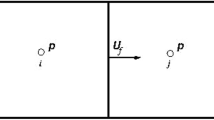Abstract
In this paper, three novel truly-explicit time-marching techniques are proposed for the solution of hyperbolic models. In these techniques, locally computed time-integration parameters are applied, which are defined taking into account the properties of the spatially/temporally discretised model and the evolution of the computed responses. These adaptive time integrators allow introducing enhanced numerical damping into the analysis, reducing spurious non-physical oscillations that occur due to the excitation of spatially unresolved modes. The proposed adaptive techniques are formulated based on second-, third-, and fourth-order accurate time-marching approaches, providing solution algorithms with different complexities. At the end of the paper, numerical results are presented, illustrating the good performance of the proposed procedures.















Similar content being viewed by others
References
Runge C (1895) Über die numerische Auflösung von Differentialgleichungen. Math Ann 46:167–178
Kutta W (1901) Beitrag Zur Näherungsweisen Integration Totaler Differentialgleichungen. Zeitschrift für mathematisch Physik 46:435–453
Newmark NM (1959) A method of computation for structural dynamics. J Eng Mech Div ASCE 85:67–94
Hilber HM, Hughes TJR, Taylor RL (1977) Improved numerical dissipation for time integration algorithms in structural dynamics. Earthq Eng Struct Dyn 5:283–292
Wood WL, Bossak M, Zienkiewicz OC (1980) An alpha modification of Newmark’s method. Int J Numer Meth Eng 15:1562–1566
Chung J, Hulbert JM (1993) A time integration method for structural dynamics with improved numerical dissipation: the generalized α method. J Appl Mech 30:371–375
Hulbert GM, Chung J (1996) Explicit time integration algorithms for structural dynamics with optimal numerical dissipation. Comput Methods Appl Mech Eng 137:175–188
Fung TC (1999) Weighting parameters for unconditionally stable higher-order accurate time step integration algorithms. Part 2: second-order equations. Int J Numer Methods Eng 45:971–1006
Fung TC (2001) Solving initial value problems by differential quadrature method—part 2: second-and higher-order equations. Int J Numer Meth Eng 50:1429–1454
Mancuso M, Ubertini F (2001) Collocation methods with controllable dissipation for linear dynamics. Comput Methods Appl Mech Eng 190:3607–3621
Fung TC (2002) Higher-order accurate time-step-integration algorithms by post-integration techniques. Int J Numer Meth Eng 53:1175–1193
Bathe KJ, Baig MMI (2005) On a composite implicit time integration procedure for nonlinear dynamics. Comput Struct 83:2513–2534
Leontyev VA (2010) Direct time integration algorithm with controllable numerical dissipation for structural dynamics: two-step Lambda method. Appl Numer Math 60:277–292
Soares D (2011) A new family of time marching procedures based on Green’s function matrices. Comput Struct 89:266–276
Noh G, Bathe KJ (2013) An explicit time integration scheme for the analysis of wave propagations. Comput Struct 129:178–193
Loureiro FS, Silva JEA, Mansur WJ (2015) An explicit time-stepping technique for elastic waves under concepts of Green’s functions computed locally by the FEM. Eng Anal Bound Elem 50:381–394
Soares D (2015) A simple and effective new family of time marching procedures for dynamics. Comput Methods Appl Mech Eng 283:1138–1166
Soares D (2016) A novel family of explicit time marching techniques for structural dynamics and wave propagation. Comput Methods Appl Mech Eng 311:838–855
Wen WB, Tao Y, Duan SY, Yan J, Wei K, Fang DN (2017) A comparative study of three composite implicit schemes on structural dynamic and wave propagation analysis. Comput Struct 190:126–149
Kim W, Reddy JN (2017) A new family of higher-order time integration algorithms for the analysis of structural dynamics. J Appl Mech 84:071008
Soares D (2018) Nonlinear dynamic analysis considering explicit and implicit time marching techniques with adaptive time integration parameters. Acta Mech 229:2097–2116
Evans JA, Hiemstra RR, Hughes TJR, Reali A (2018) Explicit higher-order accurate isogeometric collocation methods for structural dynamics. Comput Methods Appl Mech Eng 338:208–240
Xing Y, Zhang H (2018) An efficient nondissipative higher-order single-step integration method for long-term dynamics simulation. Int J Struct Stab Dyn 18:1850113
Soares D (2019) A model/solution-adaptive explicit-implicit time-marching technique for wave propagation analysis. Int J Numer Meth Eng 119:590–617
Soares D (2019) An adaptive semi-explicit/explicit time marching technique for nonlinear dynamics. Comput Methods Appl Mech Eng 354:637–662
Zhang HM, Xing YF (2019) Two novel explicit time integration methods based on displacement-velocity relations for structural dynamics. Comput Struct 221:127–141
Kim W (2019) An accurate two-stage explicit time integration scheme for structural dynamics and various dynamic problems. Int J Numer Meth Eng 120:1–28
Kim W (2019) Higher-order explicit time integration methods for numerical analyses of structural dynamics. Latin Am J Solids Struct 16:e201
Li J, Li X, Yu K (2020) Enhanced studies on the composite sub-step algorithm for structural dynamics: the Bathe-like algorithm. Appl Math Model 80:33–64
Ji Y, Xing Y (2020) Two-sub-step generalized central difference method for general dynamics. Int J Struct Stab Dyn 20:2050071
Soares D (2020) A novel time-marching formulation for wave propagation analysis: the adaptive hybrid explicit method. Comput Methods Appl Mech Eng 366:113095
Soares D (2020) Efficient high-order accurate explicit time-marching procedures for dynamic analyses. Eng Comput. https://doi.org/10.1007/s00366-020-01184-8
Soares D (2021) A multi-level explicit time-marching procedure for structural dynamics and wave propagation models. Comput Methods Appl Mech Eng 375:113647
Hughes TJR (2000) The finite element method: linear static and dynamic finite element analysis. Dover Publications INC., New York
Fried I (1972) Bounds on the extremal eigenvalues of the finite element stiffness and mass matrices and their spectral condition number. J Sound Vib 22:407–418
Acknowledgements
The financial support by CNPq (Conselho Nacional de Desenvolvimento Cientifico e Tecnológico) is greatly acknowledged.
Author information
Authors and Affiliations
Corresponding author
Appendix
Appendix
The entries of the amplification matrices A2, A3 and A4 may be specified as follows:
whereas the entries related to the load operator vectors L2, L3 and L4 may be expressed as:
Rights and permissions
About this article
Cite this article
Soares, D. Three novel truly-explicit time-marching procedures considering adaptive dissipation control. Engineering with Computers 38, 3251–3268 (2022). https://doi.org/10.1007/s00366-021-01290-1
Received:
Accepted:
Published:
Issue Date:
DOI: https://doi.org/10.1007/s00366-021-01290-1




